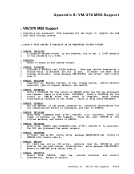initialize shadow tables.
user in
alter user's dispatching priority.
if the system is not extending.
unstack those blocks that will allow the extend to complete. If the
other processor is encountered, give up the
the other processor.
dispatching. If the system is locked for running users (such as
during extend), load a wait state.
dispatchable candidate. If none is found, load a wait state. If
there is also a runnable user for the other processor, signal the
other processor. If a runnable user is found, set up to dispatch this
user.
MKSC 1!Q1
alter the user's dispatching status and (when necessary) his
dispatching priority.
user as not runnable. If the user is in the eligible list, drop him
the queue.
queues.








































































































































































































































































































































































































































































